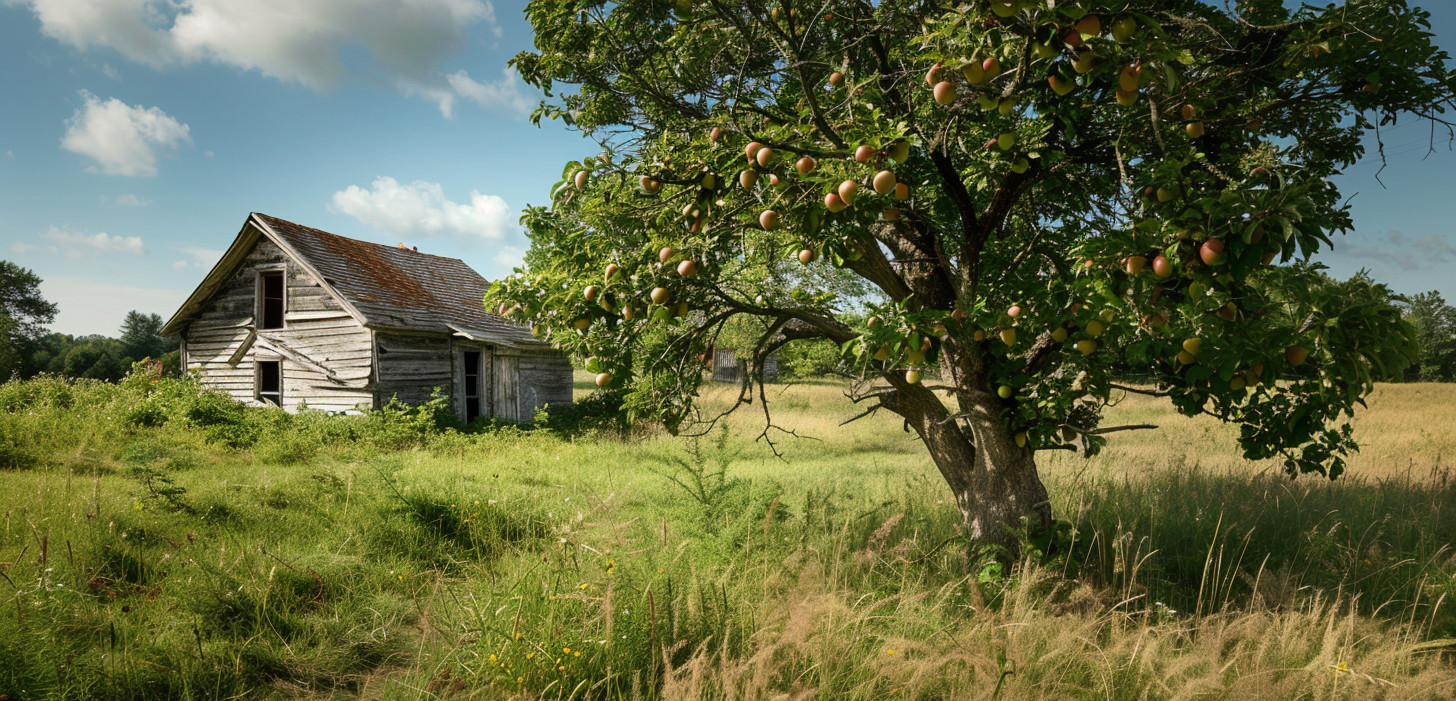“In the quiet aftermath of human departure, where once bustling homes have succumbed to the ravages of fire or the slow creep of dilapidation, old fruit trees stand as enduring sentinels of the past. These ancient guardians, their gnarled branches and resilient roots bearing silent witness to the passage of time, continue to flourish long after the dwellings they once accompanied have vanished. They offer a poignant reminder of the flavours of yesteryear, preserving the tastes of a bygone age within their steadfast boughs. Each harvest from these venerable trees serves as a tangible connection to history, providing a sensory journey to the past through the simple act of tasting a piece of fruit.”
Fruit trees trees I have known
As a young man, I hitch-hiked and walked around much of my country and in doing so encountered old building sites with perhaps just a empty shell of a house, a chimney standing amongst surrounding bush or even a set of stone and mortar steps hidden in the grass. Whenever I came upon such a site I would search the surrounds for fruit trees and invariably find them. Old apple trees, plum trees, pear trees, quince trees and even peach trees.
If the time of year was right and the local possum population hadn’t beaten me to it, there was quite often some fruit to try and collect for the journey ahead. It came to the point where I would time my travels, to visit certain roadside spots where I new the fruit would be ready and occasionally I would even set up camp under the branches to spend the night.
Long forgotten varieties
Old varieties of apples, quinces, plums, and other heritage fruits hold a unique charm, distinguished by their wholesome, robust flavours that evoke a sense of authenticity and nostalgia. Unlike today’s commercially produced fruits, often engineered for uniformity, size, and shelf-life, these heirloom varieties boast a rich concoction of tastes and textures, reflecting the diverse soil and climate conditions of their origins. Their imperfections, blemishes, varied shapes, and occasional irregularities are testament to their natural growth processes, untouched by the hands of modern genetic modification. The sweetness of an antique apple, the aromatic depth of a quince, or the juicy, nuanced flavour of a heritage plum offer an experience that modern fruit constructions, bred for convenience and aesthetics, simply cannot replicate. These old fruits serve as a flavourful reminder of nature’s original intentions, a stark contrast to the often sterile, homogenised offerings found in today’s supermarkets.
Old names
Although a traveller, sometimes I would collect and take a few of these beauties with me and sit in a town library somewhere attempting to identify them. There was seldom any success with the most unusual but I did collect a list of those early varieties that that arrived in my country with the pioneers…
Ancient Varieties of Apples, Pears, and Plums from Europe…
Apples:
- Gravenstein
- Ribston Pippin
- Sturmer Pippin
- Cox’s Orange Pippin
- Peasgood Nonsuch
- Blenheim Orange
- Kingston Black
- Irish Peach
Pears:
- Williams’ Bon Chrétien (Bartlett)
- Beurré Bosc
- Winter Nelis
- Doyenné du Comice
- Conference
- Josephine de Malines
Plums:
- Damson
- Victoria
- Greengage
- Coe’s Golden Drop
- Denniston’s Superb
- Angelina Burdett
- Orleans
These varieties were cherished for their unique flavours, adaptability, and resilience, brought to the new world by pioneers seeking to recreate a sense of home and tradition in the land.
Nutrients
Heirloom fruit varieties are not only rich in history and flavour but also in nutrients. These ancient cultivars often boast higher levels of vitamins, minerals, and antioxidants compared to their modern counterparts. Their diverse genetic makeup and traditional farming methods contribute to a more robust nutritional profile, offering essential nutrients such as vitamin C, potassium, and fiber. Consuming these fruits can enhance overall health, supporting immune function, heart health, and digestive wellness. By enjoying these nutrient-dense fruits, we nourish our bodies with the same natural goodness that sustained our ancestors.
Collectors
In recent years, a dedicated group of enthusiasts has emerged, committed to preserving and reviving the ancient varieties of apples, pears, plums and other fruit that once graced the orchards of the early settlers. These passionate individuals scour old homesteads, abandoned gardens, and heritage sites in search of cuttings from these venerable trees. With careful attention and nurturing, they propagate, and cultivate them into robust new trees that carry the genetic legacy of their ancestral predecessors. This meticulous process not only safeguards the biodiversity of our fruit heritage but also ensures that the unique, time-honoured flavours of these heirloom varieties continue to be enjoyed by future generations. Through their efforts, these collectors play a vital role in maintaining a living connection to the past, celebrating the rich agricultural history.
Farmers markets
At farmers markets, the discerning visitor may occasionally stumble upon a treasure trove of old fruit varieties, lovingly cultivated by local growers dedicated to preserving these ancient gems. These markets, vibrant with the colours and scents of freshly harvested produce, offer a unique opportunity to taste fruits that have largely disappeared from mainstream commercial shelves. Among the bustling stalls, heirloom apples with their rich, complex flavours, pears with unparalleled sweetness, and plums boasting the kind of juiciness rarely found in modern cultivars can often be discovered. These fruits, nurtured from heritage cuttings and tended with traditional farming practices, bring a piece of agricultural history to the market, providing a direct link to the past and a taste of nature’s original bounty. The growers, passionate about their craft, are often eager to share stories and tips, adding a personal touch to each purchase and deepening the appreciation for these rare and delicious fruits.
